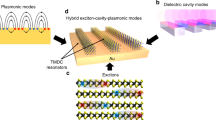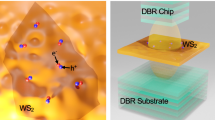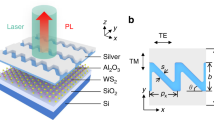Abstract
Transition metal dichalcogenide (TMD) monolayers with a direct bandgap feature tightly bound excitons, strong spin–orbit coupling and spin–valley degrees of freedom1,2,3,4. Depending on the spin configuration of the electron–hole pairs, intra-valley excitons of TMD monolayers can be either optically bright or dark5,6,7,8. Dark excitons involve nominally spin-forbidden optical transitions with a zero in-plane transition dipole moment9, making their detection with conventional far-field optical techniques challenging. Here, we introduce a method for probing the optical properties of two-dimensional materials via near-field coupling to surface plasmon polaritons (SPPs). This coupling selectively enhances optical transitions with dipole moments normal to the two-dimensional plane, enabling direct detection of dark excitons in TMD monolayers. When a WSe2 monolayer is placed on top of a single-crystal silver film10, its emission into near-field-coupled SPPs displays new spectral features whose energies and dipole orientations are consistent with dark neutral and charged excitons. The SPP-based near-field spectroscopy significantly improves experimental capabilities for probing and manipulating exciton dynamics of atomically thin materials, thus opening up new avenues for realizing active metasurfaces and robust optoelectronic systems, with potential applications in information processing and communication11.
This is a preview of subscription content, access via your institution
Access options
Access Nature and 54 other Nature Portfolio journals
Get Nature+, our best-value online-access subscription
$29.99 / 30 days
cancel any time
Subscribe to this journal
Receive 12 print issues and online access
$259.00 per year
only $21.58 per issue
Buy this article
- Purchase on Springer Link
- Instant access to full article PDF
Prices may be subject to local taxes which are calculated during checkout




Similar content being viewed by others
References
Splendiani, A. et al. Emerging photoluminescence in monolayer MoS2 . Nano Lett. 10, 1271–1275 (2010).
Mak, K. F., Lee, C., Hone, J., Shan, J. & Heinz, T. F. Atomically thin MoS2: a new direct-gap semiconductor. Phys. Rev. Lett. 105, 136805 (2010).
Xia, F., Wang, H., Xiao, D., Dubey, M. & Ramasubramaniam, A. Two-dimensional material nanophotonics. Nat. Photon. 8, 899–907 (2014).
Xu, X., Yao, W., Xiao, D. & Heinz, T. F. Spin and pseudospins in layered transition metal dichalcogenides. Nat. Phys. 10, 343–350 (2014).
Liu, G.-B., Shan, W.-Y., Yao, Y., Yao, W. & Xiao, D. Three-band tight-binding model for monolayers of group-VIB transition metal dichalcogenides. Phys. Rev. B 88, 085433 (2013).
Kośmider, K., González, J. W. & Fernández-Rossier, J. Large spin splitting in the conduction band of transition metal dichalcogenide monolayers. Phys. Rev. B 88, 245436 (2013).
Zhang, X.-X., You, Y., Zhao, S. Y. F. & Heinz, T. F. Experimental evidence for dark excitons in monolayer WSe2 . Phys. Rev. Lett. 115, 257403 (2015).
Kormányos, A. et al. K·p theory for two-dimensional transition metal dichalcogenide semiconductors. 2D Mater. 2, 022001 (2015).
Echeverry, J. P., Urbaszek, B., Amand, T., Marie, X. & Gerber, I. C. Splitting between bright and dark excitons in transition metal dichalcogenide monolayers. Phys. Rev. B 93, 121107 (2016).
High, A. A. et al. Visible-frequency hyperbolic metasurface. Nature 522, 192–196 (2015).
Poem, E. et al. Accessing the dark exciton with light. Nat. Phys. 6, 993–997 (2010).
Chance, R. R., Prock, A. & Silbey, R. in Advances in Chemical Physics Vol. 37 (eds Prigogine, I. & Rice, S. A.) 1–65 (Wiley, 1978).
Gontijo, I. et al. Coupling of InGaN quantum-well photoluminescence to silver surface plasmons. Phys. Rev. B 60, 11564–11567 (1999).
Wang, G. et al. Valley dynamics probed through charged and neutral exciton emission in monolayer WSe2 . Phys. Rev. B 90, 075413 (2014).
Schuller, J. A. et al. Orientation of luminescent excitons in layered nanomaterials. Nat. Nanotech. 8, 271–276 (2013).
Ross, J. S. et al. Electrical control of neutral and charged excitons in a monolayer semiconductor. Nat. Commun. 4, 1474 (2013).
Wang, Z., Shan, J. & Mak, K. F. Valley- and spin-polarized Landau levels in monolayer WSe2 . Nat. Nanotech. 12, 144–149 (2017).
Zhang, Y. et al. Direct observation of the transition from indirect to direct bandgap in atomically thin epitaxial MoSe2 . Nat. Nanotech. 9, 111–115 (2014).
Zhu, Z. Y., Cheng, Y. C. & Schwingenschlögl, U. Giant spin–orbit-induced spin splitting in two-dimensional transition-metal dichalcogenide semiconductors. Phys. Rev. B 84, 153402 (2011).
Slobodeniuk, A. O. & Basko, D. M. Spin–flip processes and radiative decay of dark intravalley excitons in transition metal dichalcogenide monolayers. 2D Mater. 3, 035009 (2016).
Wang, G. et al. Spin–orbit engineering in transition metal dichalcogenide alloy monolayers. Nat. Commun. 6, 10110 (2015).
Zhang, X.-X. et al. Magnetic brightening and control of dark excitons in monolayer WSe2 . Nat. Nanotech. http://dx.doi.org/10.1038/nnano.2017.105 (2017).
Molas, M. R. et al. Brightening of dark excitons in monolayers of semiconducting transition metal dichalcogenides. 2D Mater. 4, 021003 (2017).
Komsa, H.-P. & Krasheninnikov, A. V. Effects of confinement and environment on the electronic structure and exciton binding energy of MoS2 from first principles. Phys. Rev. B 86, 241201 (2012).
Chernikov, A. et al. Exciton binding energy and nonhydrogenic Rydberg series in monolayer WS2 . Phys. Rev. Lett. 113, 076802 (2014).
Mak, K. F. et al. Tightly bound trions in monolayer MoS2 . Nat. Mater. 12, 207–211 (2013).
Ganchev, B., Drummond, N., Aleiner, I. & Fal'ko, V. Three-particle complexes in two-dimensional semiconductors. Phys. Rev. Lett. 114, 107401 (2015).
Sidler, M. et al. Fermi polaron–polaritons in charge-tunable atomically thin semiconductors. Nat. Phys. 13, 255–261 (2017).
Yu, H., Liu, G.-B., Gong, P., Xu, X. & Yao, W. Dirac cones and Dirac saddle points of bright excitons in monolayer transition metal dichalcogenides. Nat. Commun. 5, 3876 (2014).
Rivera, P. et al. Observation of long-lived interlayer excitons in monolayer MoSe2–WSe2 heterostructures. Nat. Commun. 6, 6242 (2015).
Jin, C. et al. Interlayer electron–phonon coupling in WSe2/hBN heterostructures. Nat. Phys. 13, 127–131 (2017).
Nandi, D., Finck, A. D. K., Eisenstein, J. P., Pfeiffer, L. N. & West, K. W. Exciton condensation and perfect Coulomb drag. Nature 488, 481–484 (2012).
Fogler, M. M., Butov, L. V. & Novoselov, K. S. High-temperature superfluidity with indirect excitons in van der Waals heterostructures. Nat. Commun. 5, 4555 (2014).
Zomer, P. J., Guimarães, M. H. D., Brant, J. C., Tombros, N. & van Wees, B. J. Fast pick up technique for high quality heterostructures of bilayer graphene and hexagonal boron nitride. Appl. Phys. Lett. 105, 013101 (2014).
Acknowledgements
The authors acknowledge support from the DoD Vannevar Bush Faculty Fellowship (N00014-16-1-2825), AFOSR MURI (FA9550-12-1-0024 and FA9550-17-1-0002), the NSF (PHY-1506284), NSF CUA (PHY-1125846), the Gordon and Betty Moore Foundation and Samsung Electronics. All film deposition and device fabrication was carried out at the Harvard Center for Nanoscale Systems.
Author information
Authors and Affiliations
Contributions
H.P., P.K., M.D.L., A.A.H., Y.Z., A.D. and L.A.J. conceived the study and Y.Z., G.S., A.A.H., A.D., L.A.J., K.P. and A.Y.J. developed the fabrication procedure. Y.Z., G.S., A.A.H., A.D., C.S. and K.D.G. performed experiments and T.T. and K.W. performed hBN growth. D.S.W. and A.A.H. performed computational analyses and simulations. D.S.W., M.D.L. and H.P. contributed to theoretical descriptions. Y.Z., G.S., D.S.W., A.A.H., P.K., M.D.L. and H.P. wrote the manuscript, with extensive input from all authors.
Corresponding authors
Ethics declarations
Competing interests
The authors declare no competing financial interests.
Supplementary information
Supplementary information
Supplementary information (PDF 1541 kb)
Rights and permissions
About this article
Cite this article
Zhou, Y., Scuri, G., Wild, D. et al. Probing dark excitons in atomically thin semiconductors via near-field coupling to surface plasmon polaritons. Nature Nanotech 12, 856–860 (2017). https://doi.org/10.1038/nnano.2017.106
Received:
Accepted:
Published:
Issue Date:
DOI: https://doi.org/10.1038/nnano.2017.106
This article is cited by
-
Dynamical control of nanoscale light-matter interactions in low-dimensional quantum materials
Light: Science & Applications (2024)
-
Chemomechanical modification of quantum emission in monolayer WSe2
Nature Communications (2023)
-
Interaction-driven transport of dark excitons in 2D semiconductors with phonon-mediated optical readout
Nature Communications (2023)
-
Quantum interference between dark-excitons and zone-edged acoustic phonons in few-layer WS2
Nature Communications (2023)
-
Applications of bound states in the continuum in photonics
Nature Reviews Physics (2023)



